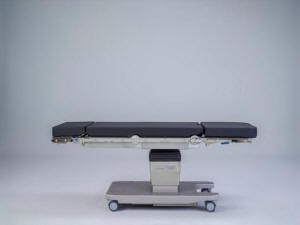|
New crop of robots to vie for space in
the operating room
 Send a link to a friend
Send a link to a friend
 [July 28, 2016]
By Susan Kelly [July 28, 2016]
By Susan Kelly
CHICAGO (Reuters) - Even though many
doctors see need for improvement, surgical robots are poised for big
gains in operating rooms around the world.
Within five years, one in three U.S. surgeries - more than double
current levels – is expected to be performed with robotic systems,
with surgeons sitting at computer consoles guiding mechanical arms.
Companies developing new robots also plan to expand their use in
India, China and other emerging markets.
Robotic surgery has been long dominated by pioneer Intuitive
Surgical Inc, which has more than 3,600 of its da Vinci machines in
hospitals worldwide and said last week the number of procedures that
used them jumped by 16 percent in the second quarter compared to a
year earlier.
The anticipated future growth - and perceived weaknesses of the
current generation of robots - is attracting deep-pocketed rivals,
including Medtronic Inc and a startup backed by Johnson & Johnson
and Google. Developers of the next wave aim to make the robots less
expensive, more nimble and capable of performing more types of
procedures, company executives and surgeons told Reuters.
Although surgical robots run an average of $1.5 million and entail
ongoing maintenance expenses, insurers pay no more for surgeries
that utilize the systems than for other types of minimally-invasive
procedures, such as laparoscopy.
Still, most top U.S. hospitals for cancer treatment, urology,
gynecology and gastroenterology have made the investment. The robots
are featured prominently in hospital marketing campaigns aimed at
attracting patients, and new doctors are routinely trained in their
use.
Surgical robots are used in hernia repair, bariatric surgery,
hysterectomies and the vast majority of prostate removals in the
United States, according to Intuitive Surgical data.
 Doctors say they reduce fatigue and give them greater precision.
But robot-assisted surgery can take more of the surgeon's time than
traditional procedures, reducing the number of operations doctors
can perform. That's turned off some like Dr. Helmuth Billy.
Billy was an early adopter of Intuitive's da Vinci system 15 years
ago. But equipping its arms with instruments slowed him down. He
rarely uses it now.
"I like to do five operations a day," Billy said. "If I have to
constantly dock and undock da Vinci, it becomes cumbersome."
SURGEONS' WISH LIST
To gain an edge, new robots will need to outperform laparoscopic
surgery, said Dr. Dmitry Oleynikov, who heads a robotics task force
for the Society of American Gastrointestinal and Endoscopic
Surgeons.
Surgeons told Reuters they want robots to provide a way to feel the
body's tissue remotely, called haptic sensing, and better camera
image quality.
[to top of second column] |

The integrated operating table, introduced earlier this year,
engineered to move in sync with the da Vinci robot, allowing the
surgeon to find the best working angle without the need to stop and
reposition the robot's arms is shown in this image taken in
Sunnyvale, California, U.S. in 2015. Courtesy Intuitive
Surgical/Handout via REUTERS

New systems also will need to be priced low enough to entice
hospitals and outpatient surgical centers that have not yet invested
in a da Vinci, as well as convince those with established robotic
programs to consider a second vendor or switching suppliers
altogether.
"That is where competitors can differentiate," said Vik Srinivasan
of the Advisory Board Co, a research and consulting firm that
advises hospitals.
Developers say they are paying attention. Verb Surgical, the
J&J-Google venture that is investing about $250 million in its
project, said creating a faster and easier-to-use system is a
priority.
Verb also envisions a system that is "always there, always on,"
enabling the surgeon to use the robot for parts of a procedure as
needed, said Chief Executive Scott Huennekens.
Intuitive said it too is looking to improve technology at a
reasonable cost, but newcomers will face the same challenges.
"As competitors come in, they are going to have to work within that
same framework," CEO Gary Guthart said in an interview.
Device maker Medtronic has said it expects to launch its surgical
robot before mid-2018 and will start in India. Others developing
surgical robots include TransEnterix Inc and Canada's Titan Medical
Inc.
An RBC Capital Markets survey found that U.S. surgeons expect about
35 percent of operations will involve robots in five years, up from
15 percent today.
J&J, which hopes to be second to market with a product from Verb,
has said it sees robotics as a multibillion-dollar market
opportunity. Huennekens said Verb's surgical robot will differ from
another Google robotics effort, the driverless car, in one important
aspect.

"There will always be a surgeon there," he said.
(Reporting by Susan Kelly; Editing by Michele Gershberg and Lisa
Girion)
[© 2016 Thomson Reuters. All rights
reserved.]
Copyright 2016 Reuters. All rights reserved. This material may not be published,
broadcast, rewritten or redistributed. |